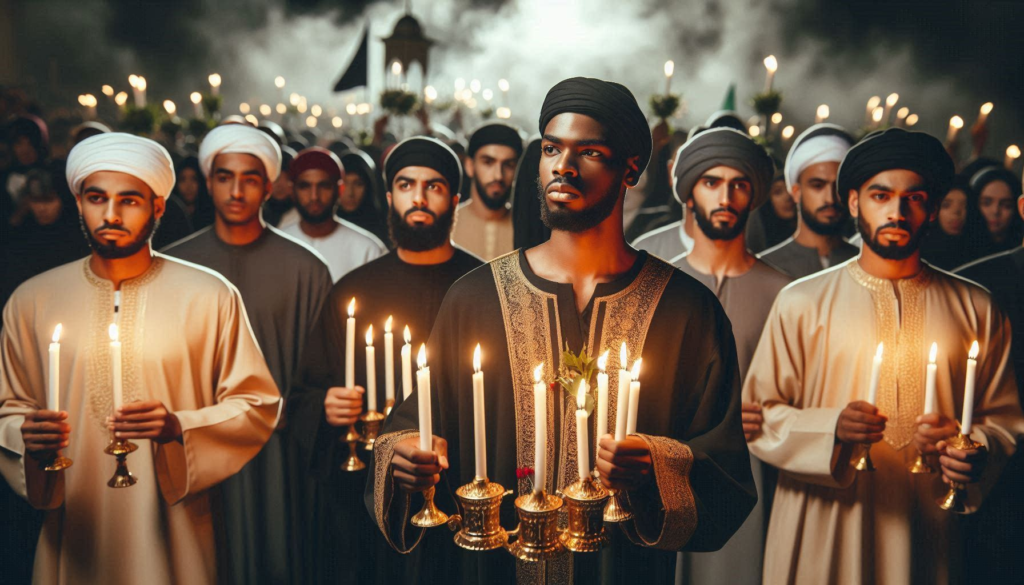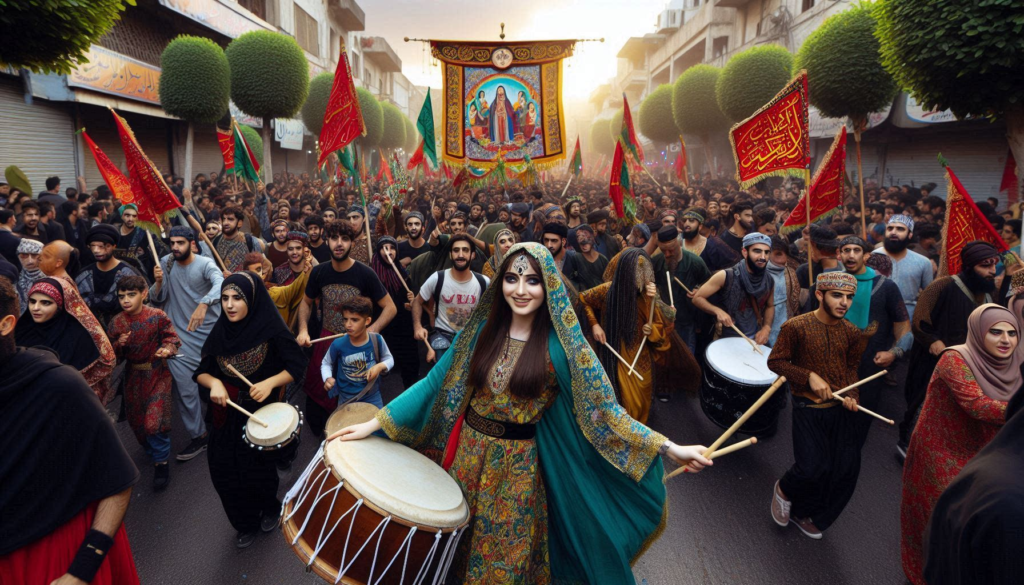Introduction
Muharram, the first month of the Islamic lunar calendar, holds significant religious importance for Muslims around the world. It is one of the four sacred months in Islam, and its tenth day, known as Ashura, is particularly noteworthy. While Muharram is observed by all Muslims, it carries special significance for Shia Muslims, who commemorate the martyrdom of Husayn ibn Ali, the grandson of Prophet Muhammad, at the Battle of Karbala. This essay explores the historical context, religious significance, and various practices associated with Muharram, delving into its profound impact on the Muslim community.

Historical Context of Muharram
Pre-Islamic Significance
The sanctity of Muharram predates Islam, with the month being considered sacred in pre-Islamic Arabia. The name “Muharram” itself means “forbidden,” reflecting its status as a time when warfare was traditionally prohibited. This period of peace allowed tribes to conduct trade and perform religious rites without the threat of conflict.
Islamic Significance
With the advent of Islam, the sacredness of Muharram was maintained. The Quran mentions the importance of the four sacred months, including Muharram, in Surah At-Tawbah (9:36):
“Indeed, Allah specified twelve months in the Book of Allah on the day He created the heavens and the earth; four of them are sacred.”

The Battle of Karbala
The most defining event associated with Muharram, particularly for Shia Muslims, is the Battle of Karbala. Husayn ibn Ali, the grandson of Prophet Muhammad, and his small group of supporters faced the forces of Yazid ibn Muawiya, the Umayyad caliph. Husayn’s refusal to pledge allegiance to Yazid, whom he viewed as an unjust ruler, led to a standoff in the desert of Karbala (modern-day Iraq).
Despite facing overwhelming odds and a lack of water, Husayn and his companions displayed incredible bravery and fought with great courage. Ultimately, Husayn and most of his family and followers were killed. This event, known as the Day of Ashura, became a symbol of resistance against tyranny and injustice, and it profoundly shaped Shia identity and religious practice.
Religious Significance of Muharram
Ashura: The Tenth of Muharram
On the 10th day of Muharram, Ashura bears immense religious significance. Both Sunni and Shia Muslims observe Ashura, but their practices and reasons for commemoration differ.
Sunni Observance
For Sunni Muslims, Ashura is a day of fasting and remembrance. It is believed that the Prophet Muhammad fasted on this day and encouraged others to do so, commemorating the day Allah saved Moses (Musa) and the Israelites from Pharaoh. The Prophet Muhammad said:
“The month of Allah, Muharram, is the best time for fasting after Ramadan. Additionally, the night prayer is considered the best prayer after the obligatory prayer.”
Fasting on Ashura is seen as an act of devotion and gratitude to Allah. Some Sunni Muslims also choose to fast on the day before (the 9th) or the day after (the 11th) Ashura, following the Prophet’s recommendation to distinguish their practice from “Similar to the Jews, who also observe this day, we should remember the significance of this occasion.”
Shia Observance
Certainly! The revised text is: “For Shia Muslims, Ashura is a day of deep mourning and reflection. Husayn’s courageous stance continues to inspire countless individuals to raise their voices against all forms of oppression and injustice. It marks the martyrdom of Husayn ibn Ali and his companions at Karbala. The event is not just a historical tragedy but a spiritual and moral lesson about standing up against oppression and injustice.
Shia Muslims engage in various forms of mourning rituals, including:
Majlis (Gatherings): These are religious gatherings where the story of Karbala is recounted, and sermons highlight the virtues of Husayn and the moral lessons from his stand.
Matam (Self-Flagellation): Some Shia Muslims participate in acts of matam, which involve chest-beating, chanting, and in some cases, self-flagellation, as a form of expressing grief and solidarity with Husayn’s suffering.
Processions: Public processions are held where participants march, recite elegies, and often carry symbolic representations of the battle, such as banners and replicas of Husayn’s shrine.
Broader Significance
Muharram, beyond the day of Ashura, is a time for reflection and spiritual renewal for all Muslims. It is a time to remember the sacrifices of the past, commit to principles of justice, and seek closer proximity to Allah through acts of worship and good deeds.
Cultural and Regional Variations in Muharram Observance
South Asia
In countries like India, Pakistan, and Bangladesh, Muharram is observed with great fervor. In addition to religious gatherings and processions, tazia (replicas of Husayn’s tomb) are often constructed and paraded through the streets. In many cities, special meals are prepared and distributed to the poor as a form of charity in memory of the martyrs of Karbala.
Middle East
In Iran and Iraq, Muharram observances are deeply ingrained in the culture. In Iran, cities like Mashhad and Qom become centers of pilgrimage and mourning rituals. In Iraq, Karbala itself becomes the focal point, with millions of pilgrims visiting Husayn’s shrine. The mourning rituals here are extensive and include passion plays known as Ta’ziyah, which dramatize the events of Karbala.
Africa
In countries like Nigeria, where there is a significant Shia population, Muharram observances include public processions and gatherings. The day of Ashura is marked by prayers, lectures, and acts of charity.
Western Countries
In Western countries with significant Muslim populations, such as the United States, Canada, and the United Kingdom, Muharram is observed in mosques and community centers. These gatherings often include lectures, recitations, and discussions about the moral and ethical lessons of Karbala. Public processions are also held in cities with large Shia communities.
Contemporary Relevance of Muharram
Lessons of Justice and Resistance
The story of Husayn ibn Ali and the Battle of Karbala continues to resonate with Muslims today. It is seen as a timeless example of the struggle against tyranny and the defense of justice and righteousness. For many, Husayn’s stand serves as a source of inspiration to speak out against oppression and injustice in all forms.
Unity and Reflection
Muharram offers a period for reflection and unity among Muslims. Despite the differences in observance, the shared significance of this sacred month provides an opportunity for dialogue and understanding between Sunni and Shia communities. It is a time to focus on common values and the shared history of the Islamic faith.
Charitable Acts
During Muharram, acts of charity and kindness are highly encouraged. Muslims are encouraged to engage in good deeds, help those in need, and strengthen their faith through acts of worship and reflection. The spirit of giving and community support is particularly evident during this month.
Challenges and Misunderstandings
Sectarian Tensions
While Muharram has the potential to unite, it can also highlight sectarian divides. In some regions, differences in observance have led to misunderstandings and tensions between Sunni and Shia communities. Efforts to promote mutual respect and understanding are essential to overcoming these challenges.
Media Portrayal
The portrayal of Muharram rituals, particularly those involving self-flagellation, can sometimes be sensationalized in the media. This can lead to misconceptions about the practices and the deeper spiritual significance behind them. It is important to approach such portrayals with sensitivity and seek to understand the underlying context and beliefs.
Conclusion
Muharram, with its profound historical and religious significance, occupies a special place in the Islamic calendar. It is a month marked by remembrance, reflection, and spiritual renewal. The story of Husayn ibn Ali and the Battle of Karbala serves as a powerful reminder of the principles of justice, sacrifice, and resistance against oppression.
While the observances of Muharram differ between Sunni and Shia Muslims, the shared reverence for this sacred month presents an opportunity for unity and mutual respect. As Muslims around the world engage in acts of worship, charity, and reflection, Muharram continues to inspire and guide the faithful in their spiritual journey.
The significance of Muharram today goes beyond just religious ceremonies. It speaks to universal values of justice, compassion, and resilience, making it a source of inspiration for all who seek to uphold these principles in their lives. Through understanding and dialogue, the lessons of Muharram can contribute to a more harmonious and just world.



